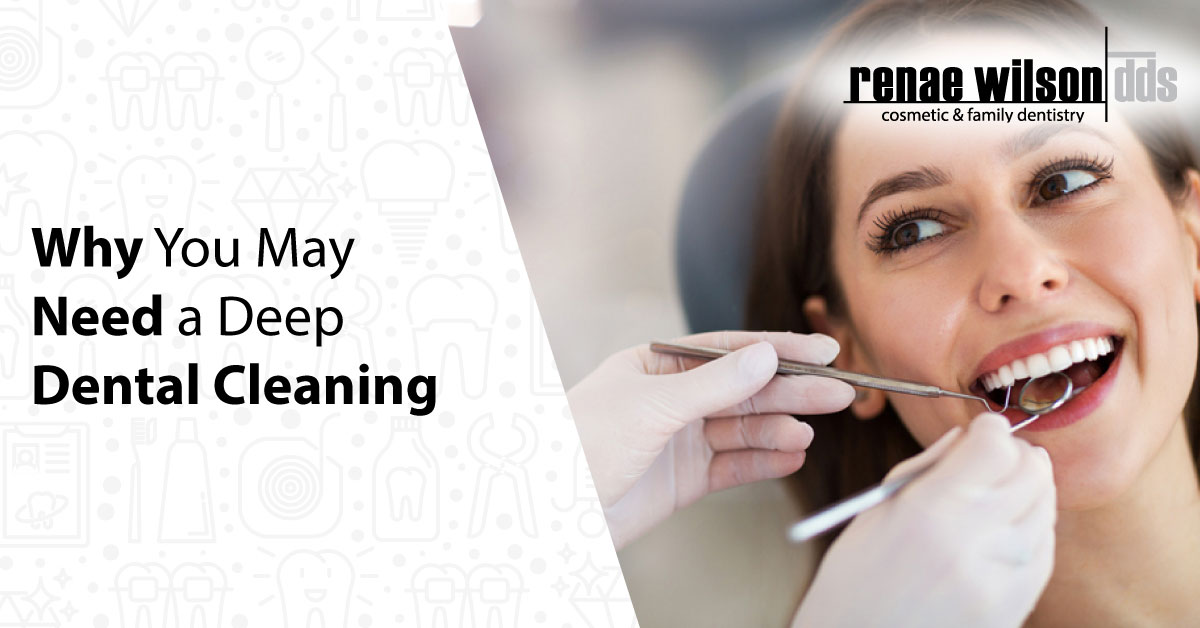
04 Feb Why You May Need a Deep Dental Cleaning
It started out as a simple dental cleaning. With your mouth agape, you hear the hygienist repeat 5 several times as she probes your teeth. You think to yourself, fives are good, right? Then the dentist comes in. She probes your back molars, takes off her mask and pats your arm gently. “You’ve got some periodontal disease in the back.” Then things get real. “You’ve got a lot of hardened tartar under your gumline. It’s irritating your gums and the bone, creating infection. A couple are deep—5 millimeters. If we don’t clear that out, you’ll eventually lose the bone mass holding your teeth in place. Which means you’ll lose those teeth. I think we should schedule you for a deep dental cleaning.” So much for fives.
Periodontal disease is a progressive gum disease
Gingivitis is when the bacteria in your mouth picnic on food particles and discard acids and plaque. When these aren’t properly removed with regular brushing, flossing, and cleanings, your gums get inflamed.
Periodontitis is what happens when that bacteria’s picnic turns into one long rave. Plaque and tartar litter your roots. Your gum tissue gets so irritated by this, it starts to pull away from the teeth. Pockets form and collect debris where bacteria continue to party unabated, causing infection. Your roots get so trashed with hardened tartar (calculus) that the bone starts to die. It takes a deep cleaning to clear the party and clean up the mess.
But Doc, I brush and floss!
If you have periodontal disease, you’re not alone. In fact, a recent Center for Disease Control report says that 47.2% of adults aged 30 years and older have some form of periodontal disease. That number climbs to 70.1% for adults 65 years and older. And it’s not just about proper brushing and flossing habits. Here are some other factors put you at risk as well:
- Aging. It’s simple. The older you get, the more likely you are to develop periodontal disease.
- Smoking. 64.2% of current smokers have gum disease. Seriously, get some help, and try to quit.
- Diabetes. Diabetic patients are at greater risk of developing periodontal disease, which in turn can make it much harder to control blood sugar.
- Diseases that compromise the immune system. If you’re battling a disease like cancer or AIDS, you’re at greater risk of developing infections, including infections under the gumline.
- Hormonal fluctuations. Women, hormones during menstruation, pregnancy, and menopause can be a ride, huh? No surprise, then, that a blast of estrogen and progesterone causes more blood to flow to your gums, which in turn makes them more sensitive to plaque and bacteria. (Why are you calling my gums sensitive?!) And those surges make you more prone to gum disease.
- Medications. Saliva is important in maintaining healthy gums and teeth. Many medications cause dry mouth. And the drier the mouth, the more prone you are to bacterial parties and gum disease.
What Goes Down in a Deep Dental Cleaning?
Look, a deep cleaning is clearly less fun than killing an hour or so in Balboa Park or snorkeling around at La Jolla. But a deep cleaning now will help you keep your teeth later. Here’s what to expect:
- Local anesthesia. Because the deep cleaning goes under the gumline where nerve endings are already irritated, your dentist will numb you with local anesthesia.
- Scaling and Root Planing. First, we carefully remove hardened deposits from the roots and then smooth or plane those surfaces so there are fewer hiding spots for bacterial parties. Plus, the smoother the root, the easier your gum tissue will reattach snuggly back to the tooth.
- Ultrasonic Scaler. In addition to periodontal hand scalers, which we use to loosen calculus (hardened tartar) from the root, we also use a zippy high-tech ultrasonic scaler. This equipment has a tiny tip that vibrates faster than the speed of sound, which blasts all those nasties from your root’s surface. Plus, the tip simultaneously shoots water to flush out all debris. This little hand-held instrument is so effective at removing buildup, disrupting bacteria, and smoothing out the root’s surface, that you’ll spend less time in the chair. And you’ll be back to Balboa or La Jolla sooner!
- After care. The treated area will be sensitive for a while. You can expect some tenderness and even some minor bleeding for about a week. This discomfort should improve by the day. Remember, your gum tissue needs some time to heal and reestablish a tight seal around the tooth. The more you can do to assist that process, which takes about six to eight weeks, the better:
- Use a soft-bristled toothbrush.
- Soothe your gums with warm salt-water rinse. Add ½ a teaspoon of salt to a cup of warm water and rinse your mouth three or four times a day the first week.
- Eat a healthy diet. Stay away from irritating or sugary treats.
We understand the symptoms of the various stages of periodontal disease. Our staff will work with you to slow the disease’s progression with a treatment appropriate for you. We work to educate you about your options at every step and ensure you are comfortable with each decision.
If you have any gum tenderness, make an appointment. We’ll get to the bottom of it. Whether you just need to be more diligent in your flossing or need a deep dental cleaning, we’re here to help you! And we’ll keep you smiling as we go!


